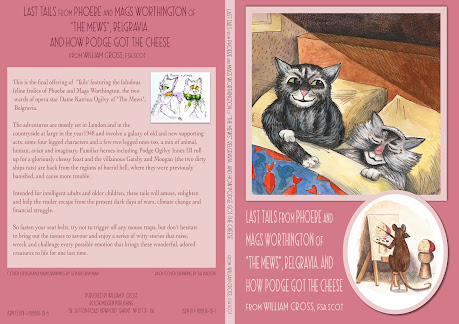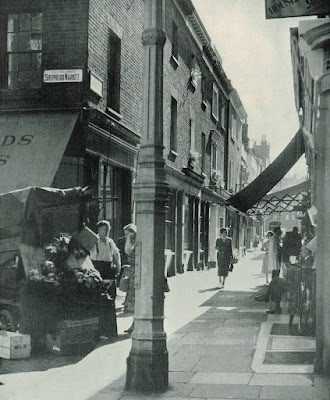Forgotten Novel From The Era Of The Bright Young Things
Published By The Fortune
Press
A BOOK REVIEW BY WILIAM CROSS, FSA SCOT
“Love is an indecent sport”
“ Woman is the Huntress, and Man the Quarry”

Book Title : Shepherd Market by Leslie Roberts
Shepherd Market : Late 1930s
“ Shepherd Market” -the
title of the book and its setting- is an
enclave between London’s Piccadilly and Curzon Street once known as
being
a part of the early to- mid 20th
century’s extraordinary low-life corner of Mayfair hosting a smattering of cheap
lodgings in a space inhabited by
criminals, spivs, prostitutes and theatrical bohemians.
The book was banned as “Indecent” in Ireland, but
praised by several British and overseas critics as a
first novel by a new author, a Nottinghamshire-London journalist, Leslie Roberts.
The Author’s style is neat,
humorous (often campy), but he offers a good mix of maverick characters and wit on par with Evelyn Waugh’s “Vile Bodies” and the mad hatters in Nancy Mitford’s romp “ In The Pursuit of Love”. It’s an easy read and a novel
overlooked featuring a few lost lambs of both the black and white wool type in the pre –WW2 London Town
and in the aftermath of the extravagances of
the era of the Bright Young
People Brigade.
A rollicking, riotous, ridiculous tale, quick paced throughout in a story about
a young man, Paul Onion who has
ambitions to escape municipal
mediocrity and establish
a name for himself as a writer and a poet.
Apparently fatherless, Paul’s mother, a self-made woman, is his
inspiration, as indeed is the Author’s
mother is his own spark, with a book dedication
“For Her Pluck and
Understanding And Naughty Sense of Humour”
The fictional Paul’s
mother’s death frees up the cantankerous youth from a likely life to come in chains and dead end jobs in the dreary coalpolis of Maidensmeadow, this being somewhere in the Midlands.
The early part of the book describes the
famous Nottingham Goose Fair, a target for
quaint description by J B Priestley as “
a crushing mass of gaping and sweating humanity".
Paul Onion is
glad to escape this hell hole. A bright lad,
handsome, hugely
opinionated, famed for winning a high school scholarship; he wont be humoured or dictated to or be bogged down by
lesser mortals and realises
his only chance of progressing
to any height is to move away from his barren roots and in so
doing changes his surname to the more
romantic “ Lovelace” out of affection for a Cavalier poet.
Paul is soon catapulted into
the wicked streets of London
where he has to grow up fast and furious and stays
just well enough off from the
proceeds of his mother estate to survive all kinds of goodies, baddies,
charlatans and creeps in a roll out of some dangerous power games, human and inhuman.
There’s a swirl of irritation and even sadness as Paul often
proves an irksome prude, nervous of sex,
a stubborn fellow, but often more canny than naive, and frequently thankless when matched in a strange
coupling cum-affair with a
gloriously well written character, an
actress- dancer, a kept woman, a fearless soul, constantly citing humorous
aphorisms in much the same style as
movie legand Mae West. She is named Desiree, and occupies one of
the flats at Mayfair Mews in Shepherd Market,
with a maid and a sweet little dog
called “ Pompey the Little”.
This is hardly a fine romance but they are locked together by
fate. Yet, Paul insists from the word go of sleeping at a nearby hotel and Desiree merely dubs him her protege, but they are clearly matched by the stars, bounce well off each other and their love-hate topsy-turvy flings and adventures occupy most
of the rest of the storyline.
There is a galaxy of
supporting characters, mainly from Desiree’s madcap stable of stage struck friends and plenty
of fiends too, including her Sugar Daddy, Sessel Cloud, a rich, witty playwright “who breeds decadent notions” and “ who is
seldom sane by daylight”. Sylvia
Moon a blonde “whose eye brows were
arched in perpetual perplexity” who is engaged to Eric “ Lousy” Lancaster, a
friend of Sessel Cloud “who keeps love birds and writes”. There’s also Lesbia Capricorn ( as the name suggests of
curious sexual tastes /gender, an exotic dancer, the star of a show called “
London Lies”, written by Sessel. The “Vile
cigar smoking Capricorn” is
always on the “whore path”.
Some of these people have
charm, some are entirely odious, all are
in constant chaos but they do amuse and keep the humour and perversions flowing
with dramas and tears aplenty.
Look out for Denise Villers “God What Legs! Like a War
Horse”, for a male ballet star named Stallion
who danced for the Csar of Russia,
and Earl Gay of Rape Royal in Sussex
“a facetious old troll.”
There’s a celebration
of Old London past decades, of the famous Lyons Corner House and nights
spent at the “ Curse of Ten” “ a cellar masquerading as a palace, the most expensive rendezvous in
Clarage’s Street” and endless Night Clubs, all hourly expecting a Police raid to descend.
The book unscrambles the tangled relationship between the would be hero, Paul and the manic neurotic heroine, Desiree and the story endures well into a series of
skimpy follies and dangerous frolics in London and Paris.
There are all the thrills
and spills of the London Season, of car
racing pranks around the metropolis’ hot spots and well known locations, in Desiree’s Silver Pelican, grand drink sex, and drug parties given by a mysterious Mrs Thursday , wife of the saintly Charles
and “ whose daughter Lucy is mated with
a title”.
Later
there’s a well written
floral description of going
by ferryboat from England to France and of the splendid sights of Gay Paris with hotel keepers like Madame Poiret who is
foolish enough to stand up to challenge Desiree.
The physiological underbelly
of the story is of Paul Lovelace’s life
and moral development from boyhood into manhood and lessons to be learned of a
youth seeking out fame and fortune,
it is a worth while read for adults.
From a witty, clever writer, good with dialogue.
Leslie Roberts (1905-66) : One of the
Brighton Belles.
Copies of “Shepherd Market" are
available from the reviewer and on Amazon and ebay
EMAIL WILLIAM CROSS
williecross@aol.com




















